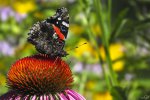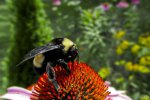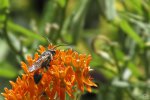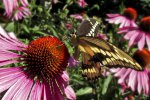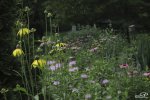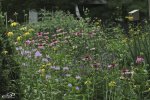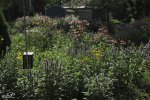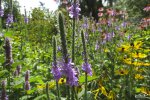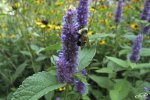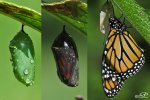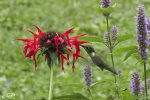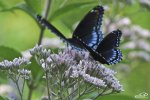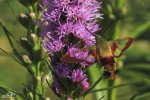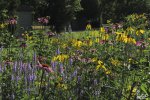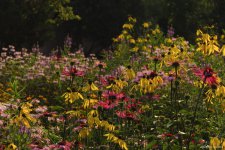Your Garden
Welcome to my native garden!



I began creating my native garden in 2014 after realizing that wildlife needs our help. It initially began as just a 64 square foot garden, but after adding on every year since, it's now over 1,000 square feet. Below, I've included a blueprint that I created of my native garden. As you can see, I have an eastern half and a western half that surrounds my fire pit and picnic table. I also have a small garden space around my shed, and a few other gardens in other parts of the yard not shown on this blueprint, including a garden pond. All gardens combined equal more than 2,000 square feet of native habitat!

My garden is a habitat restoration filled with plants that are native to North America. While a true prairie can have up to 80% grasses, I currently only have a few clumps of Side Oats Grama and Little Bluestem, and am working to seed more each year. I currently have around 35 species of forbs in my garden, with most of them being native to Wisconsin. In this photo, you can see Hoary Vervain, with Blue Giant Hyssop, Gray-headed Coneflower, Black-eyed Susan, and Purple Coneflower all blooming in the background.

This project is all about helping wildlife. Tallgrass prairie habitat is nearly extinct. Thanks to humans, less than 3% of original tallgrass prairie remains, and it's almost entirely in small fragments that are degrading with each passing year. While my garden does not make up for that lost habitat, it does provide wildlife a miniature sanctuary where they can find food and shelter. If enough people create native gardens in their backyard, it will create a chain of habitats that can help wildlife move from one larger habitat to another without struggling to find food. I've seen life increase in my native garden every year, and it's been extremely rewarding. Here are a few species that have made use of my garden.
Giant Swallowtail. The largest butterfly in the United States. Not common in Wisconsin, but I see one or two in my garden each year.

Monarch Butterfly, whose numbers have plummeted since the 90's. They are frequently seen in my garden using the nectar sources and host plants I've provided. Last year, I found my first chrysalis in the garden.

The Rusty-patched Bumble Bee. This bee made national headlines in 2017 when it became the first bumble bee to be placed on the endangered specie list. Its population has declined by 87% in the last 20 years, and will soon disappear without our help. I was shocked to find this specie in my garden last summer. Blue Giant Hyssop was its nectar source of choice.

While I wanted a very colorful garden, I also had the goal of attracting specific wildlife. I wanted to help Monarchs, so I planted multiple milkweed species as well as some of their favorite nectar sources. I wanted to help Fritillary butterflies, so I planted Common Blue Violet. I wanted to help Ruby-throated Hummingbirds, so I planted a few of their favorite plants, including Scarlet Bee Balm.

There have been other ways that I've made my garden even more beneficial to wildlife.
- I don't cut my plants down to the ground after they die off for the year. The seed heads provide food for birds in autumn and winter. After that, I cut the stems down to about one to two feet tall. Those stems will then become shelters for insects, and small, harmless bees will lay eggs in them. The stems will be hidden before summer by new growth, and will continue to benefit insects for the remainder of the year.
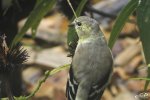
- I place a few logs randomly throughout the garden. They provide shelter for wildlife such as American Toads. Quite often, I'll lift a log to see what's under it and I'll find a Toad or two. I also have a wood pile next to the garden. Wood piles and brush piles are fantastic places for wildlife. I often find chipmunks running around the pile and searching for food.
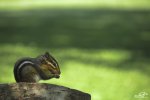
- I've added nesting boxes for birds in my garden. Wrens and Chickadees will not only make use of the boxes, but they'll also collect garden debris for their nests, and will be able to use the garden to hunt for insects for themselves and for their chicks.
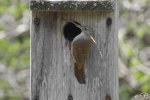
Below, I've complied a list of every plant in my main native garden, categorized by flower color. Clicking on each name will bring you to each plant's profile on either the Missouri Botanical Garden website or the Illinois Wildflowers website, to help you easily learn about any of the plants I grow.
Red
Blanket Flower (Gaillardia X grandiflora)
Scarlet Bee Balm (Monarda didyma 'Jacob Cline')
Wild Columbine (Aquilegia canadensis)
Wild Ginger (Asarum canadense)
Orange
Orange Milkweed (Asclepias tuberosa)
Yellow
Black-eyed Susan (Rudbeckia hirta)
Brown-eyed Susan (Rudbeckia triloba)
Bush's Coneflower (Echinacea paradoxa)
Common Sneezeweed (Helenium autumnale)
Gray-headed Coneflower (Ratibida pinnata)
Lanceleaf Tickseed (Coreopsis lanceolata)
Partridge Pea (Chamaecrista fasciculata)
Smooth Oxeye (Heliopsis helianthoides)
Stiff Goldenrod (Oligoneuron rigidum)
Blue
Blue-eyed Grass (Sisyrinchium angustifolium)
Confederate Violet (Viola Sororia f. princeana)
Great Blue Lobelia (Lobelia siphilitica)
Spiderwort (Tradescantia ohiensis)
Purple/ Pink
Blue Flag Iris (Iris virginica)
Blue Giant Hyssop (Agastache foeniculum)
Common Blue Violet (Viola sororia)
Hoary Vervain (Verbena stricta)
Joe Pye Weed (Eutrochium purpureum)
New England Aster (Symphyotrichum novae-angliae)
Purple Coneflower (Echinacea purpurea)
Swamp Milkweed (Asclepias incarnata)
Wild Bergamot (Monarda fistulosa)
Wild Geranium (Geranium maculatum)
White
Foxglove Beardtongue (Penstemon digitalis 'Husker Red')
Nodding Onion (Allium cernuum)
Rattlesnake Master (Eryngium yuccifolium)
Whorled Milkweed (Asclepias verticillata)
Wild Strawberry (Fragaria virginiana)
Grasses
Blue Grama (Bouteloua gracilis)
Little Bluestem (Schizachyrium scoparium)
Sideoats Grama (Bouteloua curtipendula)
Ferns
Ostrich Fern (Matteuccia struthiopteris)
Sensitive Fern (Onoclea sensibilis)
Wood Fern (Dryopteris sp.)
Please consider adding your own colorful and beneficial native plant garden!








I began creating my native garden in 2014 after realizing that wildlife needs our help. It initially began as just a 64 square foot garden, but after adding on every year since, it's now over 1,000 square feet. Below, I've included a blueprint that I created of my native garden. As you can see, I have an eastern half and a western half that surrounds my fire pit and picnic table. I also have a small garden space around my shed, and a few other gardens in other parts of the yard not shown on this blueprint, including a garden pond. All gardens combined equal more than 2,000 square feet of native habitat!
My garden is a habitat restoration filled with plants that are native to North America. While a true prairie can have up to 80% grasses, I currently only have a few clumps of Side Oats Grama and Little Bluestem, and am working to seed more each year. I currently have around 35 species of forbs in my garden, with most of them being native to Wisconsin. In this photo, you can see Hoary Vervain, with Blue Giant Hyssop, Gray-headed Coneflower, Black-eyed Susan, and Purple Coneflower all blooming in the background.
This project is all about helping wildlife. Tallgrass prairie habitat is nearly extinct. Thanks to humans, less than 3% of original tallgrass prairie remains, and it's almost entirely in small fragments that are degrading with each passing year. While my garden does not make up for that lost habitat, it does provide wildlife a miniature sanctuary where they can find food and shelter. If enough people create native gardens in their backyard, it will create a chain of habitats that can help wildlife move from one larger habitat to another without struggling to find food. I've seen life increase in my native garden every year, and it's been extremely rewarding. Here are a few species that have made use of my garden.
Giant Swallowtail. The largest butterfly in the United States. Not common in Wisconsin, but I see one or two in my garden each year.
Monarch Butterfly, whose numbers have plummeted since the 90's. They are frequently seen in my garden using the nectar sources and host plants I've provided. Last year, I found my first chrysalis in the garden.
The Rusty-patched Bumble Bee. This bee made national headlines in 2017 when it became the first bumble bee to be placed on the endangered specie list. Its population has declined by 87% in the last 20 years, and will soon disappear without our help. I was shocked to find this specie in my garden last summer. Blue Giant Hyssop was its nectar source of choice.
While I wanted a very colorful garden, I also had the goal of attracting specific wildlife. I wanted to help Monarchs, so I planted multiple milkweed species as well as some of their favorite nectar sources. I wanted to help Fritillary butterflies, so I planted Common Blue Violet. I wanted to help Ruby-throated Hummingbirds, so I planted a few of their favorite plants, including Scarlet Bee Balm.
There have been other ways that I've made my garden even more beneficial to wildlife.
- I don't cut my plants down to the ground after they die off for the year. The seed heads provide food for birds in autumn and winter. After that, I cut the stems down to about one to two feet tall. Those stems will then become shelters for insects, and small, harmless bees will lay eggs in them. The stems will be hidden before summer by new growth, and will continue to benefit insects for the remainder of the year.

- I place a few logs randomly throughout the garden. They provide shelter for wildlife such as American Toads. Quite often, I'll lift a log to see what's under it and I'll find a Toad or two. I also have a wood pile next to the garden. Wood piles and brush piles are fantastic places for wildlife. I often find chipmunks running around the pile and searching for food.

- I've added nesting boxes for birds in my garden. Wrens and Chickadees will not only make use of the boxes, but they'll also collect garden debris for their nests, and will be able to use the garden to hunt for insects for themselves and for their chicks.

Below, I've complied a list of every plant in my main native garden, categorized by flower color. Clicking on each name will bring you to each plant's profile on either the Missouri Botanical Garden website or the Illinois Wildflowers website, to help you easily learn about any of the plants I grow.
Red
Blanket Flower (Gaillardia X grandiflora)
Scarlet Bee Balm (Monarda didyma 'Jacob Cline')
Wild Columbine (Aquilegia canadensis)
Wild Ginger (Asarum canadense)
Orange
Orange Milkweed (Asclepias tuberosa)
Yellow
Black-eyed Susan (Rudbeckia hirta)
Brown-eyed Susan (Rudbeckia triloba)
Bush's Coneflower (Echinacea paradoxa)
Common Sneezeweed (Helenium autumnale)
Gray-headed Coneflower (Ratibida pinnata)
Lanceleaf Tickseed (Coreopsis lanceolata)
Partridge Pea (Chamaecrista fasciculata)
Smooth Oxeye (Heliopsis helianthoides)
Stiff Goldenrod (Oligoneuron rigidum)
Blue
Blue-eyed Grass (Sisyrinchium angustifolium)
Confederate Violet (Viola Sororia f. princeana)
Great Blue Lobelia (Lobelia siphilitica)
Spiderwort (Tradescantia ohiensis)
Purple/ Pink
Blue Flag Iris (Iris virginica)
Blue Giant Hyssop (Agastache foeniculum)
Common Blue Violet (Viola sororia)
Hoary Vervain (Verbena stricta)
Joe Pye Weed (Eutrochium purpureum)
New England Aster (Symphyotrichum novae-angliae)
Purple Coneflower (Echinacea purpurea)
Swamp Milkweed (Asclepias incarnata)
Wild Bergamot (Monarda fistulosa)
Wild Geranium (Geranium maculatum)
White
Foxglove Beardtongue (Penstemon digitalis 'Husker Red')
Nodding Onion (Allium cernuum)
Rattlesnake Master (Eryngium yuccifolium)
Whorled Milkweed (Asclepias verticillata)
Wild Strawberry (Fragaria virginiana)
Grasses
Blue Grama (Bouteloua gracilis)
Little Bluestem (Schizachyrium scoparium)
Sideoats Grama (Bouteloua curtipendula)
Ferns
Ostrich Fern (Matteuccia struthiopteris)
Sensitive Fern (Onoclea sensibilis)
Wood Fern (Dryopteris sp.)
Please consider adding your own colorful and beneficial native plant garden!

